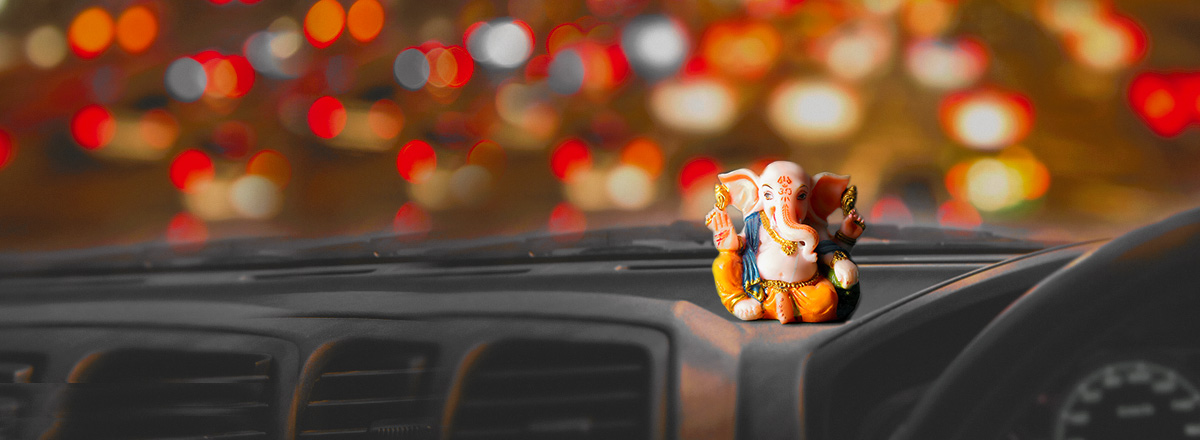A few years back I at long last met the person I had known for quite some time, but merely on the internet. I noticed that the woman always wore the same necklace and charm, a strange figure with an elephant’s head. I was curious why such a classy lady was so enamored with what appeared to be a lighthearted plastic figure. When I worked up the courage to ask the woman about this, I was ashamed of my lack of knowledge. It was the first time I’d been aware of the Hindu God Ganesh.
To a western eye, Ganesh looks very odd; a nearly comical figure that has a male’s physique (and a bit of a paunch) an elephant’s head, four arms (at least), just one tusk, and spends his time riding around on a tiny mouse. But Ganesh is absolutely not a clown and to see him as being a joke would be to misunderstand decades of belief and symbolism. He’s viewed with reverence in the Hindu faith, where the very same attributes, viewed in a different way, make him the embodiment of wisdom and learning, the patron of scientific discipline as well as the arts, the remover of obstacles, and hence summoned at the start of each and every venture as the god of success. It turned out as such that this individual wore her Ganesh charm, not really plastic but very old jade, a talisman meant to bring a favorable outcome to each of her undertakings. Like many other Hindu statues and talismans, a Ganesha statues represents specific aspirations of a productive life.
The Hindu religion is quite old and practiced over a broad area, so it isn’t really astonishing there are quite a few stories about the source of the Hindu gods. Generally in most Hindu traditions, Ganesh is the child of Shiva and his wife Parvati. Hindu’s acknowledge 4 major sects all of whom value Parvati and Shiva as significant, but for the Shakta, Parvati, whose name implies ‘she of the mountains’ is the Supreme Being and Shiva is her consort. Legend says it was Parvati who created Ganesh.
Parvati is said to value her seclusion, so one day when she wanted to wash and had no-one nearby to help keep watch for her, Parvati used turmeric paste to produce a boy. The goddess afforded him life and asked him to protect her privacy, and this is how Ganesh was created, with no real intervention from his ‘father’ Shiva.
When Shiva returned home he sought to go inside, yet Ganesh followed his Mother’s instructions and stopped him. There was a battle, and Shiva, who is Lord of Destruction, cut off the child’s head.
When she saw what had happened, Parvati’s rage knew no bounds. She demanded that Shiva fix the matter, so he directed his servants to bring back the head of the first living thing they found. The head belonged to an aged elephant they had discovered just as he was going to perish, so Ganesh was brought back to life and given the elephant’s head.
By association Ganesh is regarded as formidable, tender and loyal. Such a massive head can only be a signal of knowledge and cleverness, while the huge ears are employed to meticulously distinguish the good and the bad and to hear the requests of supplicants. Just like the elephant Ganesh is dangerous if provoked, but caring when shown kindness. Unlike most elephants, Ganesh has just one tusk.
There are numerous stories of the reason for the broken tusk; the most common is that Ganesh was handed the job of writing down the epic tale known as the Mahabharata. At some point his pen failed and rather then stopping, Ganesh detached his tusk and continued, showing he was prepared to make a sacrifice to obtain knowledge. Some other, less poetic testimonies state that the tusk was taken by a villain who stole it to create ivory earrings for lovely women.
It is not always instantly evident that a Ganesh statues has 4 (and sometimes more) arms. Some may be shown in abhaya pose that’s held up with palm out and fingers pointing upwards, while the second holds a sweet, a symbol of the inner self. The other two hands will most likely contain a goad and a noose, the former used to prod followers along the way of truth, as the latter signifies the snare of earthly desires. At his feet most statues of Ganesh show a mouse, his standard steed. The mouse is the symbolic representation of the intellect, roaming in and out, but tamed through the greater power of the whole.
Numerous devotees believe that the odd shape of the one tusked elephant headed God mirrors the symbol AUM, a symbol that symbolizes the primeval sound that was the very first thing to be created and from which the remainder of the universe came about. This is the symbol that is commonly used to symbolize all of Hinduism and its values.
Although the Hindu religion has four primary sects, all worship Ganesh, in whose image can be found across India, Nepal and many areas of the Far East. For Buddhists Ganesh appears as the god Vinayaka and is commonly displayed dancing. His statues appear in Nepal and Tibet. In Japan he is viewed as a minor god and young people call on him when searching for success in love. Throughout Malaysia, Java, Bali and Borneo you will find temples to Ganesh and in Thailand. There his position as remover of obstacles and patron of the arts mean that there is a ceremony where offerings are made to Ganesh prior to any movie or TV series starts shooting.
Indonesia is a Muslim country, however even there Ganesh is revered and his image can be found in many Cambodian temples. Yet despite spreading across the Eastern world Ganesh was not known in Europe until relatively recently, though some scholars, commenting on a sculpture of Ganesh where he’s shown with two heads (one of an elephant one of a man) facing in opposite directions have likened the image to that of Janus, the two headed God of the Romans, but no actual link between the two have been identified.
No matter what your own take on the gods from the east or of the ancients, their statues and associated symbolism will always be thought provoking. However we look at something, other civilizations often saw it very differently; one reason museum quality statues along with other artifacts make fascinating and artistic conversation pieces for any home.
<input id=”gwProxy” type=”hidden” /><input id=”jsProxy” />
<input id=”gwProxy” type=”hidden” /><input id=”jsProxy” />
<input id=”gwProxy” type=”hidden” /><input id=”jsProxy”>
Source by
Vance Lassiter





